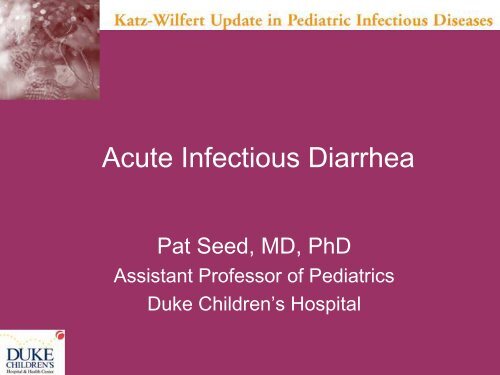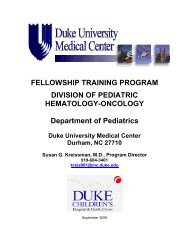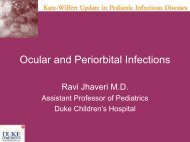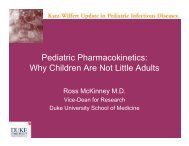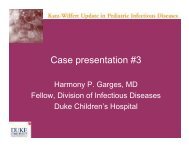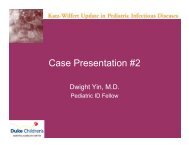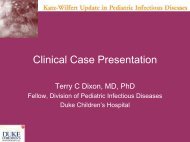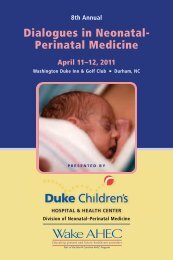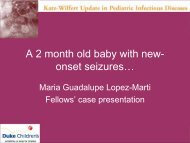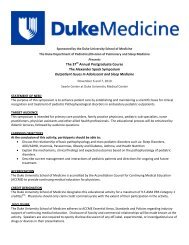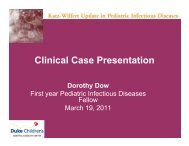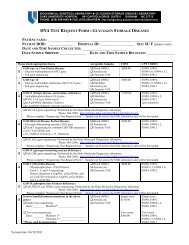Acute Infectious Diarrhea - Duke Pediatrics Intranet
Acute Infectious Diarrhea - Duke Pediatrics Intranet
Acute Infectious Diarrhea - Duke Pediatrics Intranet
- No tags were found...
You also want an ePaper? Increase the reach of your titles
YUMPU automatically turns print PDFs into web optimized ePapers that Google loves.
<strong>Acute</strong> <strong>Infectious</strong> <strong>Diarrhea</strong>Pat Seed, MD, PhDAssistant Professor of <strong>Pediatrics</strong><strong>Duke</strong> Children’s Hospital
Learning Objectives:• Know the key agents of acutegastroenteritis-infectious diarrhea• Understand role of testing• Understand the roles of oral rehydrationand antibiotic therapies ingastroenteritis-infectious diarrhea
What should you walk awaywith?• Discern NON-inflammatory vs. inflammatoryacute infectious diarrhea• Know the key agents of acute infectiousdiarrhea• Assessment of hydration and institution of oralrehydration therapy• Understand role of testing• Who needs antibiotics and who doesn’t
Illustrative Cases, cont.• A four-week-old female twin born at 37 weeks of gestation had large,watery diarrheal stools five to six times per day for three to four days,with some vomiting. She was taking formula and no clear liquids. Hertwin sister had a similar but less severe illness. The infant's neonatalcourse was normal. At two weeks of age she weighed 2.36 kg (5 lb, 3oz).• On physical examination, the infant weighed 2.05 kg (4 lb, 8 oz), with arespiratory rate of 40 and a heart rate of 120. Her temperature was 38.5C and her blood pressure measurement was 30/0 mm Hg. The patientwas lethargic and weakly responsive, with cool extremities. Herskin turgor was decreased, and capillary refilling time was about 3.0seconds.• Results of laboratory tests included the following: sodium level, 145mEq per L (145 mmol per L); potassium level, 4.2 mEq per L (4.2 mmolper L); bicarbonate level, 12 mEq per L (12 mmol per L); blood ureanitrogen level, 25 mg per dL (8.9 mmol per L); and creatinine level, 0.8mg per dL (70 µmol per L).•Rotazyme positive. Diagnosis rotovirus.
Epidemiology of <strong>Acute</strong><strong>Infectious</strong> <strong>Diarrhea</strong>• ~250-350 million cases/yr– >70 million physician visits/yr– >1.5 million hospitalizations/yr– >3,000 deaths/yr• >5 billion dollars healthcare costs/yr (probably a lothigher)• Rates are highest for < 3 yr old (2.46 cases/yr/child)• 2.5-3.5 fold increased risk with daycare• Remember how lucky we are: Developing countrieshave rates >6 cases/yr/child and poor supportive caremechanisms.
Etiologies of <strong>Acute</strong> Gastroenteritis-<strong>Infectious</strong> <strong>Diarrhea</strong> in ChildrenViral (~ 70%)• Rotavirus• Norovirus (aka Norwalk-like)• Enteric adenoviruses• Caliciviruses• Astroviruses• EnterovirusesProtozoa (
The Players and When TheyPlayJ Clin Microbiol. 2005 August; 43(8): 3636–3641.
Etiologies of Gastroenteritis inChildren by AgeJOURNAL OF CLINICAL MICROBIOLOGY, Jan. 1998, p. 133–138
Features of Children< age 5 yr with GastroenteritisJ Clin Microbiol. 2005 August; 43(8): 3636–3641.
Duration and Degree ofSymptoms with Leading ViralEtiologies of GEJournal of Medical Microbiology (2003), 52, 435–440
Mixed Infections Producing GEJournal of Medical Microbiology (2003), 52, 435–440
Things to Think About inApproaching the Patient with AID• How long have the symptoms been going on?• Is exposure to disease the right time forincubation?• What does the stool look like?• Volume/texture, blood, mucus, pus• What are the associated features?• Systemic illness? Fever?• Vomiting > diarrhea?• Abdominal pain?• Persistent abdominal pain + fever?
Epidemiology/Exposure History isKey• Co-morbidities? Immunocompromised?• Traveling? Where?• Dietary history? Specialoccasions/holidays?• Associates with vomiting/diarrhea?• Day care?• Any recent chemotherapy or antibiotics?• Sexually active/anal intercourse?
Targets for Pathogens•Viruses•Cholera•ETEC•Dysentery agents•Amoeba•Giardia•Other parasites
Stool CharacterCharacter Origin CommonOffendersFew stools but largevolume, wateryFrequent stools, smallvolumeDysenteryVomiting > diarrhea.Watery diarrhea, smallvolumeSmall bowelLarge bowelSmall bowel +/- gastricmucosaV. cholerae, ETECGiardiapersistentdiarrheaCampylobacter,Salmonella, EHECShigella, E.histolyticapersistentViral or toxin (foodpoisoning)Feel free to discuss this slide among friends over lunch………
How Long Has It BeenCookin’?Incubation Vomiting Pathogen1-6 hr ++ Think PreformedToxin!!!S. aureus, B. cereus8-16 hr +/- Toxin disease BUTmade in hostC. perfringens, B.cereus12-72 hr +/- Salmonella, Shigella,Campylobacter, Vibriospp. EIEC12-72 hr ++ Viral (Rotovirus,Norwalk etc)
Viral Pathogenesis• Infects enterocytes in smallintestine• Destroys or damages the epitheliallevel• Fluid transduced into lumen• Adjacent villi fuse – restored by 6-10 days after onset of symptoms
Rotavirus Epidemiology• Worldwide, a common cause of severegastroenteritis• 0.2 to 0.8 episodes per child-year under2 years old• Winter peak• Shedding before onset of diarrhea, then10-12 days• Found on blocks in day care centers• Annual US epidemic starts in SW,moves toward New England• Reinfections common– Seven Antigenic Groups (Group A iskey)• Nosocomial Spread – stability inenvironmentSource: CDC
Rotavirus: Still the Big Player• Currently 15 Gserotypes are definedfor Group Arotaviruses.• Serotypes G1-G4most importantglobally• Emerging globalserotypes i.e. G8, G9,G10 and G12
Clinical Rotavirus• Profuse <strong>Diarrhea</strong>• + fever• Respiratory tract symptoms• Mild LFT elevations in 2/3• Lasts 4-8 days• May have residual loose stools
http://www.cdc.gov/mmwr/preview/mmwrhtml/rr5512a1.htm
Rotateq:Re-assorted Human-Bovine Virus
REST Study• Design– Age: 6 to12 weeks at enrollment– Dose regimen: 3 oral doses every 4 to 10weeks– Formulation: Refrigerated liquidbuffer/stabilizer– Potency: 6.7 to 12.4 x 10 7– <strong>Infectious</strong> Units/DoseStudy– Period: 2001 to 2005
Confirmed Intussusception CasesOverall in REST Through One Year AfterDose One12 Vaccine : 15 Placebo
Norwalk - Virology• genus Norovirus, familyCaliciviridae• are a group of related, singlestrandedRNA, non-envelopedviruses that cause acutegastroenteritis in humans• three genogroups (GI, GII, orGIV)• each divided into >25 geneticclusters• can survive freezing andheating to 60°C (140°F).
Norwalk - Epidemiology• NLVs have been reported toaccount for 5%–17% of cases ofdiarrhea in the community• NLVs were detected in 20% of783 stool specimens collectedduring acute gastroenteritisepisodes among Finnishchildren prospectively followedfrom age 2 months to 2 yearsCenters for Disease Control and Prevention. “Norwalk-like viruses:” public healthconsequences and outbreak management. MMWR 2001;50(No. RR-9)
Norwalk - CharacteristicsCenters for Disease Control and Prevention. “Norwalk-like viruses:” public healthconsequences and outbreak management. MMWR 2001;50(No. RR-9)
Norwalk–Clinical Manifestations
Norwalk – Control/Prevention• Universal Precautions• Contact Isolation• Chlorine bleach @ 1000 ppm• Quaternary ammonium compounds(not as helpful)• Phenolic-based disinfectants (needs4X usual)• Heat disinfection (60°C)
Enteric Adenoviruses• 51 Adenovirusserotypes – Types 40and 41 are enteric (incontrast to respiratoryserotypes 3, 4, 7, 21)• ds single linear DNA• Non-enveloped, 70-90nm• 10 Structural proteins• Most frequent inchildren
Clinical GI Adenovirus• Enteric Adenoviruses do not groweasily in culture (special cell lines mayallow)• Non-enteric adenoviruses can survivetransit through the GI tract and can begrown in culture and seen on EM***THIS IS AN IMPORTANT THEME: ENTERIC VIRUSES ARE NOT EASILYCULTURED, MAKING STOOL VIRAL CULTURE A POOR CHOICE FORDIAGNOSING ENTERIC VIRAL ETIOLOGIES. THINK IMMUNOASSAYS, PCR, OREM!
Sapovirus (What’s that?)• A calicivirus like norovirus• Accounted for 9% of acute gastroenteritis in children inFinland• Similar symptoms• RT-PCR (research labs)\• EIA developed although not commercial•>19% of cases in Osaka City, Japan in 2004-2005, leadingahead of rotavirusPang, X. L.,et al. 2000. J. Infect. Dis. 181(Suppl. 2):S288-S294.Pang, X. L., et al. 1999. Pediatr. Infect. Dis. J. 18:420-426.
<strong>Infectious</strong> Dose-EntericsEnterics (lactose nonfermenting)Non-typhi Salmonellasp.ShigellaYersiniaCampylobacter jejuniEpidemiologyZoonotic- domestic and wildanimals-retail ground meat (20 + %)Human (+/- non-humanprimates)Zoonotic- domestic & wild(pigs, cows, sheeps)Zoonotics- domesticatedanimals and petsHigh rates in chicken (60%)<strong>Infectious</strong> DoseMode of Infection•High ID 50 (~10 6 )•Contaminated food•Pet exposure•Low ID 50 (~100)•Person-person (~20%)•Fecal contaminated food orwater•ID 50 (~10 6-9 )•Uncooked meat,contaminated food, water,•High unpasteurized ID 50milk•Contaminated food, water,milk•Direct contact with pets
Clinical Manifestations-EntericsEnterics (lactosenon-fermenting)Clinical Complications Antimicrobials?Non-typhiSalmonella sp.•Fever•Gastroenteritis•Endovascular disease(greatest in older patients)•< 6 mo old•Toxin/bacteremic•Moderate fecal PMN•ImmunocompromisedShigella•Watery to dysentery•Toxic megacolon•Treat all•Leukomoid reaction•Reactive arthritis (2%)•Seizures•High fecal PMN•Hemolytic-uremic syndrome(HUS)Yersinia•Fever, pain, diarrhea•Reactive arthritis•Depends on severity•Invasive ileitis, colitis•Bacteremic/Toxic•Mesentericlymphadentitis (clinicallylike appy)•+/- PMNsC. jejuni •Dysentery-acute colitis•Fecal PMN present•Reactive arthritis, 1%•Guillain-Barre•Treat severe cases
<strong>Infectious</strong> Dose-E. coliEscherichia coli Epidemiology <strong>Infectious</strong> DoseMode of InfectionETEC Most traveler’s diarrhea •High ID 50•Fecal contaminated food,water, milkEHECZoonotic•Ruminants, 10%•Low ID 50•Person-to-person•Retail beef, 1%•Poorly cooked beef, fecalcontamination, water, milkEIECEPEC/EAECOutbreaks ofcontaminated food•Mostly in developingcountries•Highest attack rate oninfants/children•High ID 50•Contaminated food•High ID 50•Person-to-person (someoutbreaks in daycares)
Clinical Manifestations-E. coliE. Coli Clinical Complications Antimicrobials?ETEC•Voluminous and watery•Self-limiting•Treat•No marked fever•No fecal PMN•DehydrationhypotensionshockEHEC•Dysentery•HUS in ~ 7-10% of children•Avoid antibiotics•Minimal fever•TTP in adults•Fecal PMN presentEIEC•Shigella-like•Like Shigella•Treat•Dysentery•Toxic megacolon•Fecal PMN present•Reactive arthritis, 2%•HUSEPEC/EAEC•Like ETEC but lowervolume•Longer course than ETEC•+/- antibiotics•Fever in youngchildren>older•No fecal PMN
Summary: Complications of<strong>Acute</strong> <strong>Diarrhea</strong>ComplicationBacteremiaConvulsions and feverEncephalopathyExtraintestinal infectionsGuillain-Barre SyndromeTypical Agent(s)Salmonella, YersiniaShigella, Campylobacter, SalmonellaShigella > SalmonellaSalmonella > othersCampylobacter jejuniHemolytic-uremic syndrome E. coli 0157:H7MeningitisReactive arthritisBowel perforation; toxic megacolon; secondarybacteremiaDural sinus thrombosis; renal vein thrombosis;transient methmoglobinemia; UTIConvulsions/altered mental statusSubdural effusionsSalmonella (neonates-young infants)Salmonella, Shigella, Campylobacter, YersiniaDysentery groupAny severe diarrheaSevere diarrhea with electrolyte imbalance<strong>Diarrhea</strong> with hypernatremia
http://www.cincinnatichildrens.org/svc/alpha/h/health-policy/ev-based/gastroenteritis.htmWork Up and Treatment
Assessment and Management ofDehydrationElliot, EJ. BMJ 2007; 334; 35-40
Diagnosis-Why?• Impact on treatment• Need antibiotics?• What kind of antibiotics (resistance etc)?• Expected clinical course• Public Health• Part of an outbreak• Unexplainable etiologies (emerging infections)• Hospital isolation-Infection Control
Bacterial/Parasite Stool Testing• If bloody diarrhea, need to do culturesand toxin testing• In in hospital >3 days then standardstool cultures/tests are very low yield.• Immunocompromised patients deserveconsideration of diverse pathogens.
Testing for Viruses• Will testing change your clinicalmanagement?• Adenovirus/rotovirusELISA• NorovirusRT-PCR• Astrovirusesresearch labsNote the absence of viral culture!
Why not treat?• Not necessary- self-resolving andresponsive to OHT• Antibiotic resistance• Modification of GI flora• Increased risk of HUS if EHEC +antibiotics?
http://www.cincinnatichildrens.org/svc/alpha/h/health-policy/ev-based/gastroenteritis.htm
Prevention• Hygiene• Public sanitation• Food/domestic animal testing• Appropriate antibiotic usage• Vaccination• Rotateq• Salmonella


